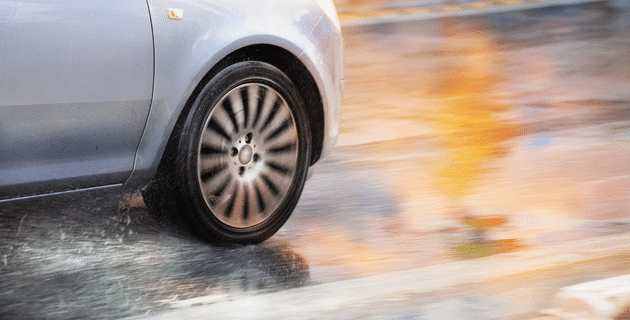There are few things scarier than losing control of your car, but when it’s wet outside it can happen in an instant, no matter how safely you drive. This phenomenon is known as hydroplaning and it’s common during spring storms.
Here are some ways to reduce your chance of hydroplaning when you’re behind the wheel, and how to keep your car under control if you do.
What is hydroplaning?
Hydroplaning happens when your tires encounter more water than they can scatter. As a result, your tires lift up off the road and start riding on a layer of water. You lose traction, braking, and steering as your car skids and slides all over. It’s easy to crash. The more water there is, the more chance you might hydroplane. However, hydroplaning also can occur when roads are just slightly wet. The first 10 minutes of a light rain can be dangerous as water mixes with the oil residue and creates a slippery road surface.
Knowing what causes hydroplaning can help you take steps to avoid it. Hydroplaning is caused by a combination of three things:
-
- Wet conditions
- Your speed
- The condition of your tires
How to lower your chances of hydroplaning
1. Reduce your speed.
Hydroplaning is more likely to happen when you’re traveling faster than 35 mph. Plan your travels in the rain so that you can move more slowly. Also avoid sudden increases in speed, such as when passing cars. Those increases can cause your car to hydroplane.
2. Choose high-quality tires.
Your tires are your car’s first defense against hydroplaning. The tread or grooves are designed to push water aside. Make sure you invest in high-quality tires. Replace them when the tire tread has worn down. Driving on bald tires is especially dangerous in wet conditions.
3. Keep your tires well-maintained.
Make sure to rotate and balance your tires to help the tread wear evenly. Rotate the tires every other time you do an oil change, about every 7-10,000 miles. Also, make sure to keep your tires properly inflated.
4. Avoid puddles and standing water.
Spring storms can create puddles and standing water. If you see them, try not to drive through them. Also, avoid driving in the outer lanes where water tends to accumulate. Follow the tire tracks of the vehicle in front of you. Their tires already did some of the work of displacing the water. Just don’t follow too closely in case you have to slow down or stop unexpectedly.
5. Avoid hard braking and sharp or quick turns.
Sudden quick movements can cause hydroplaning. If you have to turn, take it slowly. Avoid any type of sudden braking. Stay in your lane.
6. Don’t use cruise control in the rain.
You’ll have to react immediately if you start to hydroplane. You don’t want to take extra time to disengage cruise control. In the moment, every second counts.
If you hydroplane, here’s what to do.
-
- Take your foot off the gas. This will help to slow you down.
-
- Do not slam on the brakes. That may be your natural instinct, but slamming on the brakes can cause your car to skid further out of control. If you need to brake, use a light pumping motion.
-
- Gently steer in the direction your car is sliding. This will help your tires realign and allow you to gain control of the steering.
-
- When you feel the tires reconnect with the road surface, take control of the steering. You’re now good to proceed on your journey. You may want to pull over to a safe spot to regroup and calm down before going on.
Accidents can happen. Make sure that your vehicle is fully covered for added peace of mind.
Safe travels.
This article is furnished by California Casualty, providing auto and home insurance to educators, law enforcement officers, firefighters, and nurses. Get a quote at 1.866.704.8614 or www.calcas.com.
- Graduation – When to Remove Your Child from Your Auto Policy - May 18, 2023
- How to Prevent Catalytic Converter Theft - May 17, 2023
- How Much Does Home Insurance Cost? - May 17, 2023

